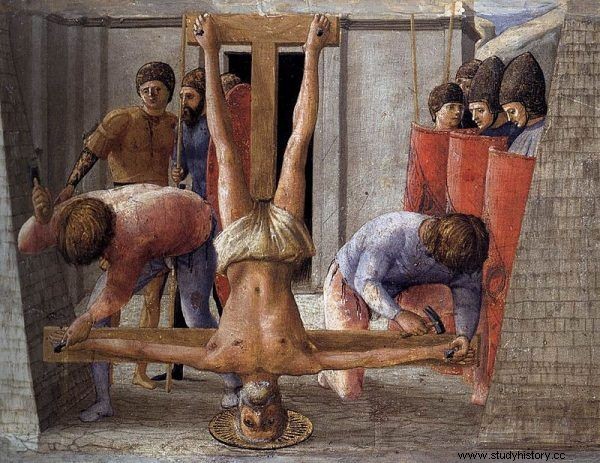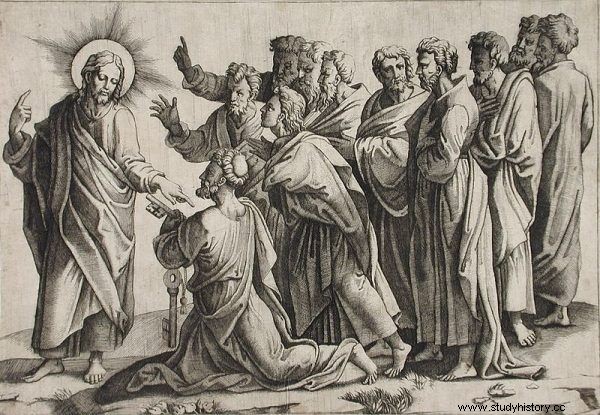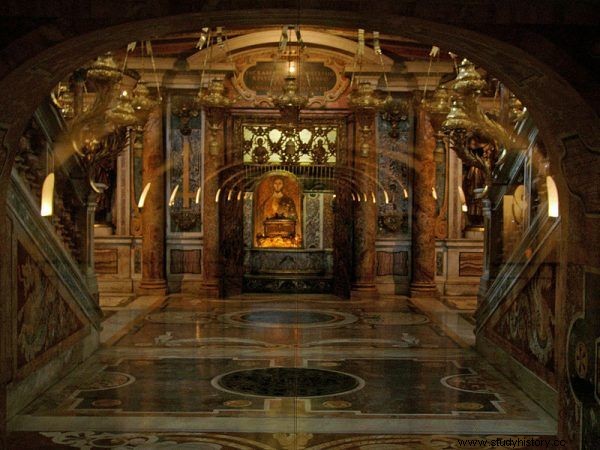Seemingly, the place of this burial does not raise any doubts. It took more than a thousand years for them to become seriously questioned. What do we know about the location of the second most important tomb in the history of Christianity? And will we ever know for sure where it is?
It seems that there is nothing simpler than pointing to the place of eternal rest of Saint Peter, the first Pope, to whom - as the Gospel proclaims - Jesus Christ himself entrusted the leadership of the Church. Already in the 4th century AD, thanks to the Emperor Constantine, the first basilica was built over the tomb. This building has not survived to this day - but to the newer one, erected in its place in the 16th century, millions of believers make pilgrimages every year.

Following Catholic tradition, Saint Peter founded a Christian community in Rome. Was he really in the Eternal City?
The belief that at some point after Christ's death, Peter ended up in the Eternal City and died a martyr's death there is a fundamental element of the Catholic tradition. It is even reported that his "pontificate" as bishop of Rome lasted 25 years. Hence the prophecy that no pope would survive on the throne for so long, falsified only in the nineteenth century thanks to Pius IX, who ruled for 32 years. There is also an account of the death of the most important apostle:he is said to have died crucified, at his own request upside down, so as not to die like his Teacher.
The problem is that gradually the whole story began to be questioned. After all, even the popes were not sure if the remains of the alleged first bishop of Rome were actually found under the temple in the Vatican . It was only in 1940 that Pius XII ordered their search. How is that possible?
Over five hundred years of doubt
The thesis that Peter's tomb does not have to be under the basilica floor was, of course, the first to be put forward by heretics. The Waldensians, representatives of the small South French sect founded in the 12th century, did not believe at all in the presence of an apostle in the Eternal City. "The Waldensians considered everything that was not certified in the Bible false" - explains Paweł Lisicki in the book "The fisherman's grave" - "They believed that the tradition of Peter's arrival in Rome, which formed the foundation of the papacy, was false."

Saint Peter reportedly died crucified, upside down at his own request, so as not to die like his Teacher.
Similar suspicions were expressed - in a more convincing form - by the fourteenth-century philosopher Marsilius of Padua. "It cannot be proved from the Scriptures that [Peter - ed. A.W.] was the bishop of Rome, or, even more so, that he had ever been to Rome, "he wrote. It was based on the fact that there is no direct mention in the Bible of the apostle's presence at the future seat of the papacy. And he commanded:
It seems supremely astonishing if, according to some popular stories, Saint Peter was to come to Rome before Saint Paul and preach the word of God there and be imprisoned (…). All this is so amazing, I repeat, because Saint Luke who wrote Acts and Paul himself made no mention of Saint Peter's presence .
In the following centuries, Luther and Calvin made almost the same arguments. Doubts in this matter, however, only fully arose in the nineteenth century. At that time, almost all the premises on which the Catholic tradition was based were questioned. It was argued that "Babylon" mentioned by Peter himself in his first epistle did not necessarily mean Rome.
The extra-biblical testimonies that had so far formed the basis of the story of the first pope were also questioned:the apocryphal "Acts of Peter", mentions of Tertullian, Clement of Alexandria, Hippolytus, Origen, Jerome ... Peter Schaff, nineteenth-century Christian theologian and author of the eight-volume history of the Church (reissued until today) Catholic, suggested, for example, that they all wrongly associated Peter with Paul who was in Rome:
(...) this can be explained by the possible fact that some "Rome arrivals" who witnessed the Pentecost miracle and heard Peter's sermon, as well as some disciples , scattered abroad (...) brought the seeds of the gospel to Rome, and it was those converted by Peter who became the true founders of the Jewish-Christian congregation in the metropolis. Thus Peter's indirect action was naturally turned into direct action by the tradition that forgot the names of the students, glorifying the teacher .

Learn the greatest secret of the Vatican underground thanks to the book by Paweł Lisicki "The Fisherman's Tomb" (Fronda Publishing House 2019).
As in the book "The Fisherman's Tomb" emphasizes Paweł Lisicki, there are still many supporters of this and similar positions - or maybe they even dominate? One of them is the classical philologist Otto Zwierlein. "According to Professor Zwierlein, Piotr has never been in Rome, and all reports on this subject are a record of errors and mistakes in translation, which he discovered after twenty centuries" - summarizes the Polish journalist.
Theology professor Frederick C. Grant was just as strict. In his opinion, all the testimonies of the first bishop's stay in Rome come down to "indications, innuendo, timid and vague references." It must be admitted, however, that on the other side of the barricade, the same premises are assessed completely differently. "As to Peter's stay in Rome and his performance as First Apostle, there is no reasonably justified historical doubt," argued Cardinal Gerhard Müller, former Prefect of the Congregation for the Doctrine of the Faith.
Excavations under the basilica
The Catholics undoubtedly hoped that Pius XII's commissioned archaeological work in front of the basilica would cut through the centuries-long disputes. It turned out, however, that - as the Catholic author George Weigel put it - "archeology is not algebra" and is not always able to give unambiguous answers.

Did Peter, whom Christ entrusted with leadership of the Church, really settled in Rome?
So what has been established over the course of two decades of research? Paweł Lisicki, based on the works of Michael Hesemann, in the book "The fisherman's grave" he tried to summarize. Discovered:
- empty tomb from 1st century AD,
- a funerary monument from the 2nd century AD,
- a wall with a hiding place from the 3rd century, on which numerous invitations to Christ, Mary and Saint Peter are engraved,
- there were bones in the stash that [most likely - ed. A.W.] moved from the tomb dating back to the 1st century,
- they were revered because they bear traces of purple streaked with gold,
- marked with PETROS EN I relating to the Apostle
- all bones belong to the skeleton of one man, which - in terms of age and stature - corresponds to the portrait of St. Peter,
- the lack of bones in the feet may additionally be an indication that the information about cross-death head downwards conveyed by tradition is true.
The author, convinced of the authenticity of Peter's remains, adds one more argument to this list, namely "no mention in the historical sources of any other burial place of Peter and Paul". He also argues that the discoveries made in recent years at St. Paul's Basilica, where the remains were also found wrapped in purple with golden thread, further strengthen the thesis that both apostles were buried in the Eternal City.
Professor Margherita Guarducci, who was directly involved in the research, was also a strong advocate of the view that the tomb and bones of the first bishop of Rome were found. It was she who managed to read many of the inscriptions on the walls, she also suggested that the inscription "PETROS ENI" should be understood as "Peter [is] in the center". Finally, it was she who noticed the remains that had previously been left untouched in the box for over ten years.

The alleged tomb of Saint Peter in the Vatican is visited by millions of believers every year.
Surprisingly reserved for this ... the popes themselves. On Christmas Eve 1950 Pius announced that the tomb had been located; he had not yet commented on the remains as the archaeological work was still ongoing. In turn, Paul VI in 1968, admittedly stated that the relics had been found, but he put it cautiously, saying that "they were identified in a way that we consider convincing" . Later, he showed a similar distance. As Paweł Lisicki tells in the book "The fisherman's grave ” :
nine bone fragments were separated and enclosed in a silver reliquary made by the sculptor Egidio Giaroli at the request of the private secretary of Paul VI, Monsignor Macchi. The small, casket-like reliquary was to be placed in the private chapel of the Pope. What must have struck was the formula that was on the reliquary:instead of saying directly that these were Peter's bones, the inscription stated that what was in the reliquary "considered" to belong to Peter .
And perhaps no more can be added to this papal assessment. Only a DNA test would decide the matter unequivocally - but since we have almost no information about Piotr's descendants, there is nothing to compare this genetic material with. So it seems the discussion is far from over.
Check where to buy the “Fisherman's Grave. Investigation into the greatest secret of the Vatican underground ":
